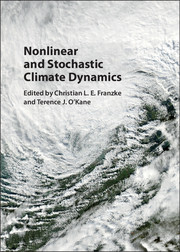Book contents
- Frontmatter
- Contents
- List of Figures
- List of Contributors
- Preface
- 1 Challenges for Ice Age Dynamics: A Dynamical Systems Perspective
- 2 Tipping Points in the Climate System
- 3 Atmospheric Teleconnection Patterns
- 4 Atmospheric Regimes: The Link between Weather and the Large-Scale Circulation
- 5 Low-Frequency Regime Transitions and Predictability of Regimes in a Barotropic Model
- 6 Complex Network Techniques for Climatological Data Analysis
- 7 On Inference and Validation of Causality Relations in Climate Teleconnections
- 8 Stochastic Climate Theory
- 9 Stochastic Subgrid Modelling for Geophysical and Three-Dimensional Turbulence
- 10 Model Error in Data Assimilation
- 11 Long-Term Memory in Climate: Detection, Extreme Events, and Significance of Trends
- 12 Fractional Stochastic Models for Heavy Tailed, and Long-Range Dependent, Fluctuations in Physical Systems
- 13 Modelling Spatial Extremes Using Max-Stable Processes
- 14 Extreme Value Analysis in Dynamical Systems: Two Case Studies
- Index
10 - Model Error in Data Assimilation
Published online by Cambridge University Press: 26 January 2017
- Frontmatter
- Contents
- List of Figures
- List of Contributors
- Preface
- 1 Challenges for Ice Age Dynamics: A Dynamical Systems Perspective
- 2 Tipping Points in the Climate System
- 3 Atmospheric Teleconnection Patterns
- 4 Atmospheric Regimes: The Link between Weather and the Large-Scale Circulation
- 5 Low-Frequency Regime Transitions and Predictability of Regimes in a Barotropic Model
- 6 Complex Network Techniques for Climatological Data Analysis
- 7 On Inference and Validation of Causality Relations in Climate Teleconnections
- 8 Stochastic Climate Theory
- 9 Stochastic Subgrid Modelling for Geophysical and Three-Dimensional Turbulence
- 10 Model Error in Data Assimilation
- 11 Long-Term Memory in Climate: Detection, Extreme Events, and Significance of Trends
- 12 Fractional Stochastic Models for Heavy Tailed, and Long-Range Dependent, Fluctuations in Physical Systems
- 13 Modelling Spatial Extremes Using Max-Stable Processes
- 14 Extreme Value Analysis in Dynamical Systems: Two Case Studies
- Index
Summary
Abstract
This chapter provides various perspectives on an important challenge in data assimilation: model error. While the overall goal is to understand the implication of model error of any type in data assimilation, we emphasize on the effect of model error from unresolved scales. In particular, connection to related subjects under different names in applied mathematics, such as the Mori-Zwanzig formalism and the averaging method, was discussed with the hope that the existing methods can be more accessible and eventually be used appropriately. We will classify existing methods into two groups: the statistical methods for those who directly estimate the low-order model error statistics; and the stochastic parameterizations for those who implicitly estimate all statistics by imposing stochastic models beyond the traditional unbiased white noise Gaussian processes. We will provide theory to justify why stochastic parameterization, as one of the main theme in this book, is an adequate tool for mitigating model error in data assimilation. Finally, we will also discuss challenges in lifting this approach in general applications and provide an alternative nonparametric approach.
Introduction
Data assimilation (or Bayesian filtering) is a statistical method to find the conditional distribution of the hidden variables of interest given noisy observations from nature. In application, the hidden variables of interest can be the state variables that are directly or indirectly observed or can even be some unobserved parameters in the models. In practice, data assimilation is typically realized by numerical schemes that produce conditional statistics of the state variables of interests, accounting for the information from the observations, rather than the corresponding conditional distribution; this gives a reasonable justification why we called it a “statistical method”. When observations are available at discrete times, Bayesian filtering is an iterative predictor-corrector scheme that adjusts the prior forecast (background) statistical estimates from a predictor (or dynamical model) to be more consistent with the current observations. This correction step is referred to as analysis in the atmospheric and ocean science (AOS) community. Subsequently, the posterior (corrected or analysis) statistical estimates are fed into the model as initial conditions for future time prior statistical estimates.
- Type
- Chapter
- Information
- Nonlinear and Stochastic Climate Dynamics , pp. 276 - 317Publisher: Cambridge University PressPrint publication year: 2017
- 9
- Cited by



